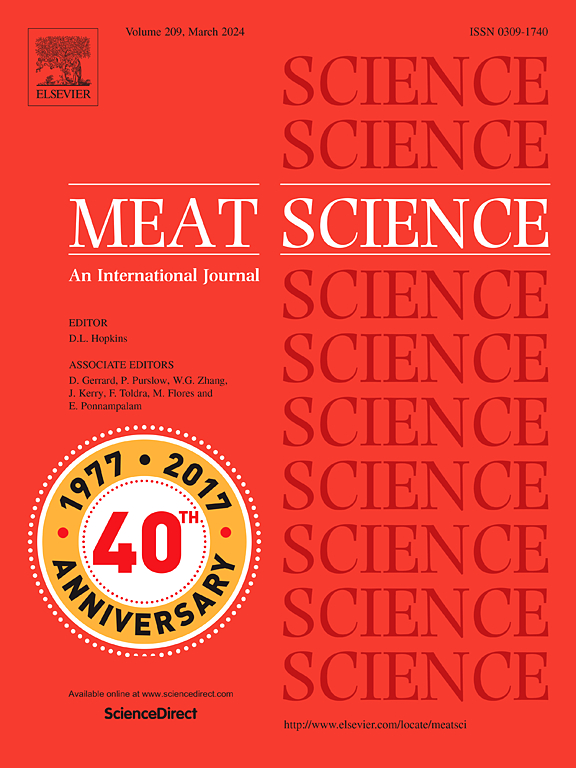生长速率和肥育制度改变了籼稻杂交牛的肉色和死后早期代谢
IF 6.1
1区 农林科学
Q1 Agricultural and Biological Sciences
引用次数: 0
摘要
本研究的目的是探讨生长速度和育肥制度(饲养场或牧场)对死后肌肉代谢和随后牛肉颜色发育的影响。选用72头安格斯×内洛尔杂交阉牛,随机分为4组处理:1)饲养场,高生长率(FH);2)饲养场,生长率(FL)低;3)牧草,高生长速率(PH)和4)牧草,低生长速率(PL)。收获的动物要么是恒定体重(体重);530公斤)或饲料日(DOF;140 d)。PL牛肤色较深(P <;0.001)瘦,pH下降较慢(P = 0.006),最终(24小时)pH值较大(P = 0.005),最长肌的糖酵解电位较低(P = 0.019)。与FL牛相比,PH牛的肌肉在体外糖酵解系统中具有相似的肌肉能量代谢和牛肉颜色属性。生长速度对死后牛肉代谢和颜色属性的影响,在恒定体重终点收获时比在恒定DOF收获时更为显著。饲喂方式和生长速度对肉质性状均有影响。这些结果表明,在试图优化牛肉品质发展时,应仔细考虑饲养策略,特别是鲜色。本文章由计算机程序翻译,如有差异,请以英文原文为准。
Growth rate and finishing system alter beef color and early postmortem metabolism in Bos indicus crossbred cattle
The aim of this study was to explore the effects of growth rate and finishing system (feedlot or pasture) on postmortem muscle metabolism and subsequent beef color development. Seventy-two Angus × Nellore crossbred steers were randomly assigned to one of four treatment combinations: 1) feedlot, high growth rate (FH); 2) feedlot, low growth rate (FL); 3) pasture, high growth rate (PH) and 4) pasture, low growth rate (PL). Animals were harvested either at a constant body weight (BW; 530 kg) or days on feed (DOF; 140 d). PL cattle had darker (P < 0.001) lean, slower (P = 0.006) pH declines and greater (P = 0.005) ultimate (24 h) pH values, as well as lower glycolytic potentials (P = 0.019) in the Longissimus muscle compared to FH cattle when harvested based on DOF. Muscle from PH had similar muscle energy metabolism when subjected to an in vitro glycolysis system, and beef color attributes compared to those of FL cattle. Growth rate influenced postmortem beef metabolism and color attributes more notably when harvested at a constant BW endpoint compared to those harvested on a constant DOF. Both feeding regime and growth rate affected meat quality characteristics. These results demonstrate that feeding strategies should be carefully considered when attempting to optimize beef quality development, especially fresh color.
求助全文
通过发布文献求助,成功后即可免费获取论文全文。
去求助
来源期刊

Meat Science
工程技术-食品科技
CiteScore
12.60
自引率
9.90%
发文量
282
审稿时长
60 days
期刊介绍:
The aim of Meat Science is to serve as a suitable platform for the dissemination of interdisciplinary and international knowledge on all factors influencing the properties of meat. While the journal primarily focuses on the flesh of mammals, contributions related to poultry will be considered if they enhance the overall understanding of the relationship between muscle nature and meat quality post mortem. Additionally, papers on large birds (e.g., emus, ostriches) as well as wild-captured mammals and crocodiles will be welcomed.
 求助内容:
求助内容: 应助结果提醒方式:
应助结果提醒方式:


